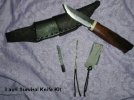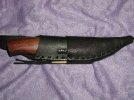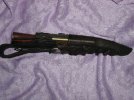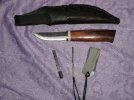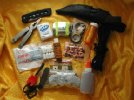- Joined
- Nov 30, 2000
- Messages
- 191
Lauri Survival Kit Knife
Some of you may remember my first effort at assembling a basic survival knife kit. Here is my latest result.
My thought process was something like this: In the event I had to quickly grab a knife that might be my only implement under survival conditions what tools besides the knife might I also need?
My Criteria:
· Light weight and small enough to fit in a pocket or wear on a belt
· The ability to cut (not chop) most anything
· The ability to maintain cutting effectiveness for a period of time
· The ability to start a fire under emergency conditions
Heres what I came up with:
The Knife: A Lauri carbon bladed Puukko design made for me by Dennis Holmbacka of Finland.
I chose a Puukko design because of the inherent toughness and cutting ability of Puukkos. I chose carbon versus stainless or other alloy because it will take and hold an edge for a long time and the edge is very easy to maintain with minimal effort.
The Sharpener: A flat 2.50 x .75 diamond impregnated plate.
I found these in the fishing section of a local sporting good store. They are sold as hook sharpeners but do very nicely as blade sharpeners in a pinch. I dont remember the manufacturers name.
I tied a 2.50 length of nylon cord through the hole in one end to give me a bit more something to hang onto since the plate is quite small.
The Fire Starter: A .125 diameter, 2.0long ferrocerium rod from Hoods Woods.
I epoxied about .250 inch of the rod into a 1.0 length of brass tubing along with a double 2.50 length of nylon cord. I sacrificed the .250 of rod to gain 3.0 of something more to hang onto.
The Striker is a saber saw blade. I purchased a two pack at the hardware store for $1.89. I rounded both ends and wrapped 20# nylon fishing line around about .625 of the (formerly) notched end and coated the line with epoxy. Again, this was done to improve the grip.
The Sheath: My own creation.
Pouch style 8-9 oz. leather, wet molded to the knife. A second layer of supple 2-3 oz. leather was sewn over the lower 2/3s of the sheath and serves as a pocket for the sharpener, the ferrocerium rod and the striker. I deliberately overlapped and left the excess leather of the second layer on because I like the way it looked. In a real pinch, I could trim the excess off, slice it into strips and make a cord out of it for that matter; the entire sleeve could be removed and used as raw material for cord.
The entire package is compact, lightweight and meets my criteria. By itself, this knife and associated items would give me an edge in a survival situation. When combined with my pocket survival pouch, I have a real opportunity compete with Mother Nature on her terms.
As a footnote, the only other item I considered for this kit was a compass. I can determine general direction via sun and stars so it was not considered essential. Having said that, a compass cant be beat on cloudy days! I will add a compass if I find a rugged, small, accurate compass that could be attached to the sheath or one of the existing implements.
Some of you may remember my first effort at assembling a basic survival knife kit. Here is my latest result.
My thought process was something like this: In the event I had to quickly grab a knife that might be my only implement under survival conditions what tools besides the knife might I also need?
My Criteria:
· Light weight and small enough to fit in a pocket or wear on a belt
· The ability to cut (not chop) most anything
· The ability to maintain cutting effectiveness for a period of time
· The ability to start a fire under emergency conditions
Heres what I came up with:
The Knife: A Lauri carbon bladed Puukko design made for me by Dennis Holmbacka of Finland.
I chose a Puukko design because of the inherent toughness and cutting ability of Puukkos. I chose carbon versus stainless or other alloy because it will take and hold an edge for a long time and the edge is very easy to maintain with minimal effort.
The Sharpener: A flat 2.50 x .75 diamond impregnated plate.
I found these in the fishing section of a local sporting good store. They are sold as hook sharpeners but do very nicely as blade sharpeners in a pinch. I dont remember the manufacturers name.
I tied a 2.50 length of nylon cord through the hole in one end to give me a bit more something to hang onto since the plate is quite small.
The Fire Starter: A .125 diameter, 2.0long ferrocerium rod from Hoods Woods.
I epoxied about .250 inch of the rod into a 1.0 length of brass tubing along with a double 2.50 length of nylon cord. I sacrificed the .250 of rod to gain 3.0 of something more to hang onto.
The Striker is a saber saw blade. I purchased a two pack at the hardware store for $1.89. I rounded both ends and wrapped 20# nylon fishing line around about .625 of the (formerly) notched end and coated the line with epoxy. Again, this was done to improve the grip.
The Sheath: My own creation.
Pouch style 8-9 oz. leather, wet molded to the knife. A second layer of supple 2-3 oz. leather was sewn over the lower 2/3s of the sheath and serves as a pocket for the sharpener, the ferrocerium rod and the striker. I deliberately overlapped and left the excess leather of the second layer on because I like the way it looked. In a real pinch, I could trim the excess off, slice it into strips and make a cord out of it for that matter; the entire sleeve could be removed and used as raw material for cord.
The entire package is compact, lightweight and meets my criteria. By itself, this knife and associated items would give me an edge in a survival situation. When combined with my pocket survival pouch, I have a real opportunity compete with Mother Nature on her terms.
As a footnote, the only other item I considered for this kit was a compass. I can determine general direction via sun and stars so it was not considered essential. Having said that, a compass cant be beat on cloudy days! I will add a compass if I find a rugged, small, accurate compass that could be attached to the sheath or one of the existing implements.

